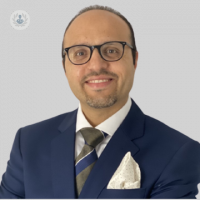All you need to know about AMD
Written by:In this article below, revered consultant ophthalmologist, Mr Sami Habal, details when patients with wet age-related macular degeneration (AMD) should seek medical attention, and how the condition is generally treated.

What is the prevalence of wet age-related macular degeneration (AMD)? Who is at risk?
It is a very common eye disease in communities. This disease increases accordingly with increased age. Also, patients with a strong family history of AMD are at an increased risk when it comes to developing signs and symptoms of AMD.
Moreover, smoking and poor diet and nutrition are both also considered as risk factors in relation to developing AMD. Finally, cardiovascular diseases including high blood pressure have also been associated with the progression of AMD.
Are both eyes affected?
Most patients have AMD in both eyes. They may present with different stages of the disease though. Treating AMD in one eye might detect an early AMD development in the other eye by screening both eyes at the same time. Treatment at the earliest possible stage can possibly save vision in the second eye.
When should patients seek medical attention?
The AMD disease usually affects the central part of the retina. Therefore, any subtle changes or deterioration in central vision should alert individuals and urge them to seek medical attention by having an urgent eye consultation. Early detection of wet AMD development may save sight by treating it in its early stages.
How is wet AMD treated by intravitreal anti-VEGF injections and by photodynamic therapy?
Dry AMD is a very widespread disease in the elderly population. Most cases do not significantly affect the vision, apart from a proportion of patients with a more severe form of dry AMD. It is generally very difficult to treat dry AMD.
Having said that though, wet AMD can be treated with a course of anti-VEGF intravitreal injections (injections inside the eye). There are different protocols for treatment, but the majority of patients would be expected to receive between five to seven injections over a 12-month period. We no longer treat wet AMD with photodynamic therapy (laser) because the latter creates permanent macular scar and may adversely affect central vision.
How important are diet and supplements in the treatment of wet AMD?
Some studies have suggested that taking nutritional supplements (vitamins and minerals) might help slow this eye disease in specific forms of AMD. This includes people who have a lot of drusen (tiny yellow deposits under the retina), and may also lower the risk of wet AMD and vision loss in the second eye of people who lost vision in one eye from AMD.
To schedule in an appointment with Mr Sami Habal today, visit his Top Doctors profile.


